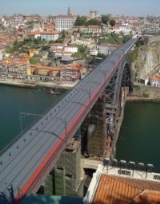
Dom Luís Bridge, Porto
Encyclopedia
The Luís I Bridge is a metal arch bridge
that spans the Douro River between the cities of Porto
and Vila Nova de Gaia
in Portugal
. At the time of construction its span of 172 m was the longest of its type in the world.
The Government held a competition for the construction of a metallic bridge over the Douro River on a site that was adjacent to an existing bridge and would replace it. Téophile Seyrig had already engineered the D. Maria Pia Bridge
project nearby, whilst working as a partner of Eiffel
. He now took sole responsibility for the new, major Luís 1st Bridge. The construction was begun in 1881 and the bridge opened on 31 October 1886.
 Originally built to take road traffic on both decks, at various times it saw tram
Originally built to take road traffic on both decks, at various times it saw tram
s on the upper and trolleybus
es on the lower. The top deck is now occupied by Line D of the Metro do Porto and a pedestrian walkway.
Arch bridge
An arch bridge is a bridge with abutments at each end shaped as a curved arch. Arch bridges work by transferring the weight of the bridge and its loads partially into a horizontal thrust restrained by the abutments at either side...
that spans the Douro River between the cities of Porto
Porto
Porto , also known as Oporto in English, is the second largest city in Portugal and one of the major urban areas in the Iberian Peninsula. Its administrative limits include a population of 237,559 inhabitants distributed within 15 civil parishes...
and Vila Nova de Gaia
Vila Nova de Gaia
Vila Nova de Gaia, or simply Gaia is a city in Vila Nova de Gaia Municipality, Portugal. It is located in the Porto District, south of the city of Porto on the other side of the Douro River. The city proper has a population of 178,255 and the municipality contains 24 parishes with a total...
in Portugal
Portugal
Portugal , officially the Portuguese Republic is a country situated in southwestern Europe on the Iberian Peninsula. Portugal is the westernmost country of Europe, and is bordered by the Atlantic Ocean to the West and South and by Spain to the North and East. The Atlantic archipelagos of the...
. At the time of construction its span of 172 m was the longest of its type in the world.
The Government held a competition for the construction of a metallic bridge over the Douro River on a site that was adjacent to an existing bridge and would replace it. Téophile Seyrig had already engineered the D. Maria Pia Bridge
Maria Pia Bridge
The Maria Pia bridge , commonly known as Ponte Dona Maria, is a railway bridge built in 1877 by Gustave Eiffel in Porto, Portugal...
project nearby, whilst working as a partner of Eiffel
Gustave Eiffel
Alexandre Gustave Eiffel was a French structural engineer from the École Centrale Paris, an architect, an entrepreneur and a specialist of metallic structures...
. He now took sole responsibility for the new, major Luís 1st Bridge. The construction was begun in 1881 and the bridge opened on 31 October 1886.
- Total length 385.25 m
- Weight 3045 tons
- The arch measures 172 m in length and 44.6 m in height

Tram
A tram is a passenger rail vehicle which runs on tracks along public urban streets and also sometimes on separate rights of way. It may also run between cities and/or towns , and/or partially grade separated even in the cities...
s on the upper and trolleybus
Trolleybus
A trolleybus is an electric bus that draws its electricity from overhead wires using spring-loaded trolley poles. Two wires and poles are required to complete the electrical circuit...
es on the lower. The top deck is now occupied by Line D of the Metro do Porto and a pedestrian walkway.

